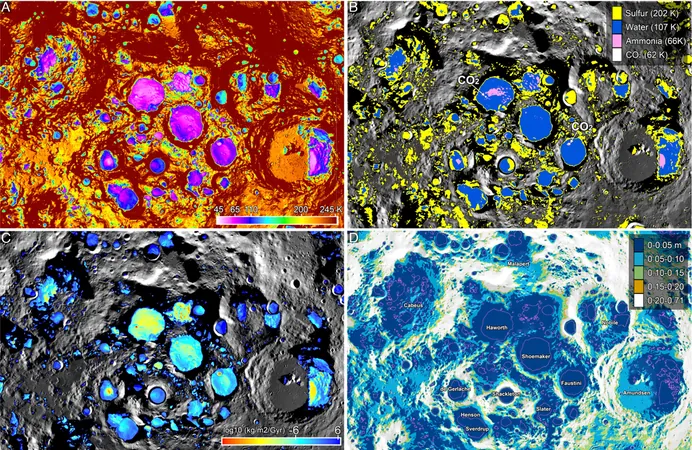
Uncovering Lunar Secrets: Scientists Investigate Polar Cold Traps for Hidden Resources
2024-12-18
Author: John Tan
In a groundbreaking study conducted by researchers at The University of New Mexico, scientists are diving deep into the mysteries of the Moon's polar regions, specifically its frigid South Pole, which experiences even colder extremes than the notoriously freezing conditions found in Antarctica. With temperatures plunging to a staggering -400°F in permanently shadowed areas, this celestial body offers a unique opportunity to explore the potential resources locked away for billions of years.
The study, published in the *Proceedings of the National Academy of Sciences*, focuses on the analysis of lunar volatiles—essentially gases and organic compounds that could be vital for future human missions and colonization efforts. The research team, led by Charles Shearer and co-authored by Zachary Sharp from UNM and Julie Stopar from the Lunar and Planetary Institute, emphasizes that understanding these volatiles offers insights not only into the Moon's geology but also its utility for human exploration.
"Water, oxygen, and other elements stored in these cold traps could be fundamental not just for surviving on the Moon but also for long-term missions beyond," Shearer stated. The impending NASA Artemis missions, especially Artemis III—which aims to land the first crew on the Moon since the Apollo program—is specifically targeting these polar regions to capitalize on their resources.
However, extracting and analyzing these resources presents monumental challenges. The harsh, frigid conditions of the lunar South Pole impede exploration efforts, where temperatures can reach an astonishing -423°F. Sharp highlights the risk of bringing these samples back to Earth at higher temperatures, which could change their states from solids to gases, potentially resulting in the loss of crucial information. Addressing the need for optimized storage conditions is vital for maximizing data retention.
There’s also the potential for high-pressure scenarios when gases are sealed in containers, which could pose dangers if not carefully managed during transport back to Earth. The research underscores the importance of meticulous engineering strategies to ensure that these volatile samples are preserved accurately.
NASA's focus on the lunar South Pole is strategic for various reasons, including the scientific importance of studying one of the oldest geological formations in the solar system. "The insights we gather from these samples could inform us about the moon's impact history and the broader dynamics of the solar system," asserted Shearer.
Moreover, New Mexico is positioning itself as a pivotal player in the space economy. Public and private investments are surging in the state to develop technologies that support space exploration. With facilities like Spaceport America and significant national laboratories, New Mexico is fostering a robust infrastructure for scientific inquiry and innovation in space technologies.
As the Artemis missions progress, the studies conducted by UNM researchers are setting the stage for future exploration. "We're merely scratching the surface in understanding the Moon's resources and environment," remarked Sharp. Each successive mission carries the promise of new discoveries, as we work toward unraveling the enigmatic features of our lunar neighbor.
As humanity edges closer to expanding its presence beyond Earth, the trials and triumphs of missions to the Moon will significantly shape our understanding of neighboring celestial bodies. With promising data from the polar cold traps, the Moon may soon offer more than just a destination—but a foundation for sustainable exploration and habitation in our solar system.

 Brasil (PT)
Brasil (PT)
 Canada (EN)
Canada (EN)
 Chile (ES)
Chile (ES)
 España (ES)
España (ES)
 France (FR)
France (FR)
 Hong Kong (EN)
Hong Kong (EN)
 Italia (IT)
Italia (IT)
 日本 (JA)
日本 (JA)
 Magyarország (HU)
Magyarország (HU)
 Norge (NO)
Norge (NO)
 Polska (PL)
Polska (PL)
 Schweiz (DE)
Schweiz (DE)
 Singapore (EN)
Singapore (EN)
 Sverige (SV)
Sverige (SV)
 Suomi (FI)
Suomi (FI)
 Türkiye (TR)
Türkiye (TR)